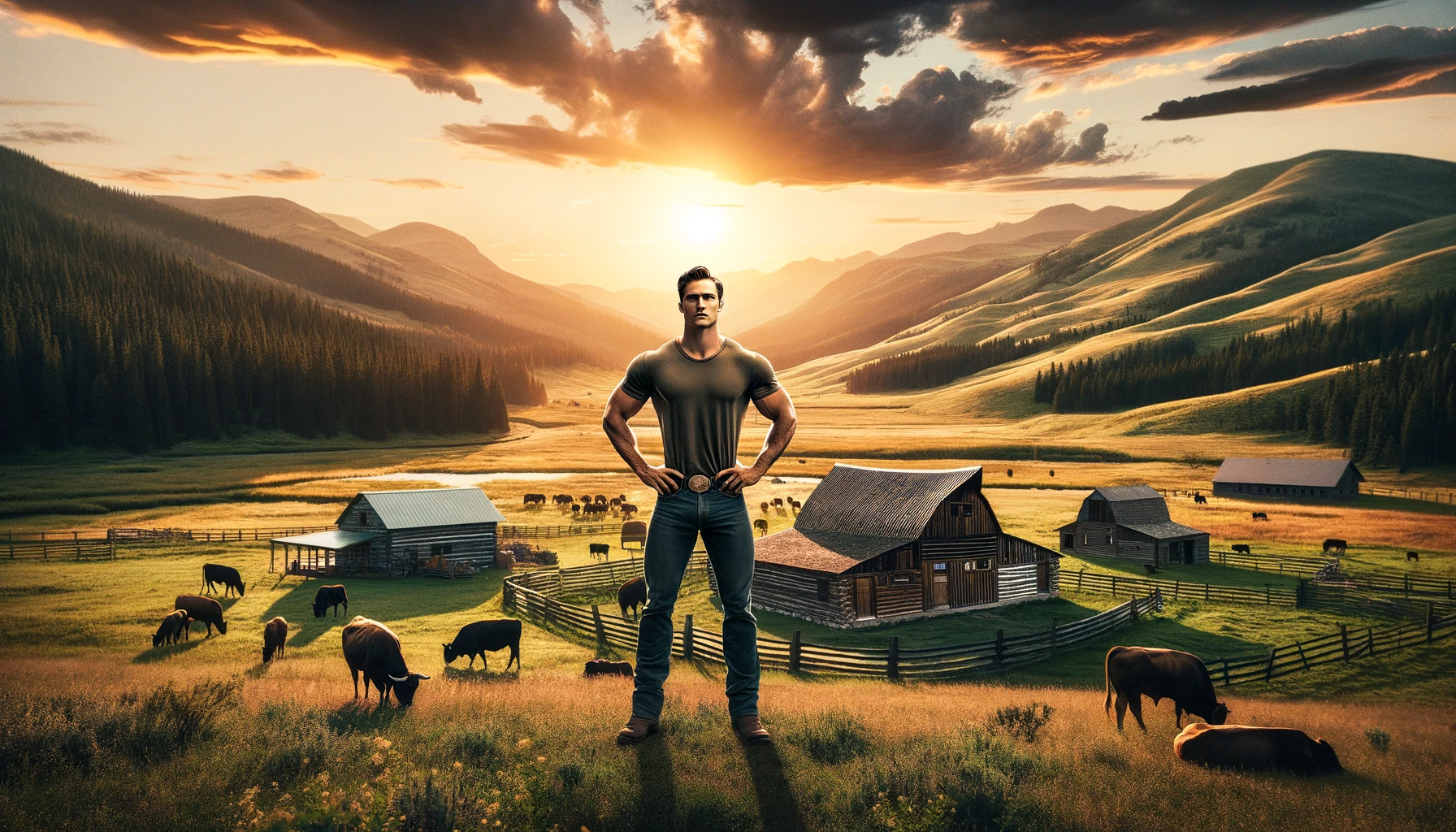
so you want to be a cowboy 182.png
Learn the Art of Becoming a Cowboy on a Ranch: A Guide for Aspiring Yellowstone Wannabees
Are you ready to ride into the wild west? Discover the challenges, skills, and unique lifestyle of a cowboy in this engaging article. From the uncertainties of ranching to mastering the art of horseback riding, being a cowboy demands dedication and a strong work ethic. Building a relationship with horses and saddling them correctly are crucial aspects of this way of life. So, if you’re curious about what it takes to be a cowboy, saddle up and dive into this fascinating exploration.
Key Takeaways
- Ranching is a tough business with fluctuating prices and regulations.
- Riding a horse requires proper technique and balance.
- Building a relationship with horses is crucial for effective communication and trust.
- Properly saddling a horse is important for comfort and safety.
Challenges of Ranching

Ranching poses numerous challenges that require dedication and hard work. Cowboys who work on a ranch face a variety of obstacles that test their skills and resilience. One of the main challenges is managing the cattle. These animals can be unpredictable, often trying to escape or harm themselves. Cowboys must constantly be vigilant and use their rodeo skills to handle the cattle safely.
Another challenge is the harsh and unpredictable weather conditions that can affect ranch work. Blizzards, droughts, and extreme temperatures can make it difficult to care for the cattle and maintain the ranch. Cowboys must be prepared to face these challenges and adapt their work accordingly.
Furthermore, ranching is physically demanding, especially when it comes to riding horses. Cowboys need to have strong riding skills and maintain proper technique and balance. Riding a horse requires practice and experience, as well as the ability to bounce with the horse’s movements. It is essential for cowboys to ride correctly and sit back in the saddle when the horse comes down to maintain stability.
Despite these challenges, cowboys are dedicated to keeping cowboy traditions alive and preserving the cowboy way of life. They understand that hard work is necessary, and they take pride in their ability to overcome obstacles. Ranching requires a deep love for the job, a strong work ethic, and a willingness to face the challenges head-on.
Learning to Ride

Cowboys who are dedicated to the challenging lifestyle of ranching must first learn the essential skill of riding a horse. Riding a horse is more than just sitting in a saddle; it requires knowledge of proper technique, balance, and communication with the horse. Cowboys must master the art of bouncing with the horse’s movements while maintaining stability by sitting back in the saddle when the horse comes down. It can be physically demanding, especially for beginners, but practice and experience make riding easier over time.
Saddling a horse is another important skill for a cowboy to learn. Properly securing the saddle using the cinch and latigo ensures comfort and safety for both the cowboy and the horse. Each piece of equipment, from the saddle to the rope, plays a crucial role in the cowboy’s safety, so it’s essential to check and maintain them regularly. Cowboys must also know how to tie knots correctly to prevent accidents.
Learning to ride is not just about mastering the physical aspects; it’s also about building a relationship with the horse. Cowboys must understand and communicate effectively with their horses, developing trust and mutual respect. The bond between a cowboy and their horse is essential in their work, as they rely on each other to navigate the ranch, herd cattle, and mend fences.
While traditional skills and knowledge are at the heart of being a cowboy, it’s important to adapt to the modern world. Cowboys should embrace social media to share their experiences and promote the cowboy way of life. However, they must also preserve the traditions and values that define the cowboy culture.
Building a Relationship With Horses

To truly become a cowboy, one must establish a strong bond with their equine partner through effective understanding and communication. Building a relationship with horses is an essential aspect of being a cowboy. The cowboy tradition values horsemanship and recognizes the importance of a deep connection between rider and horse.
Working on a ranch provides the perfect opportunity for amateur cowboys to gain experience with horses. Regular horseback riding allows them to develop their skills and become more comfortable in the saddle. By spending time with horses, cowboys can learn to read their body language, understand their needs, and communicate with them effectively.
Horsemanship is not just about riding; it involves caring for the horse as well. Cowboys must ensure their horses are well-fed, groomed, and have access to clean water and proper shelter. By taking care of their horses, cowboys build trust and mutual respect.
Social media savvy cowboys may also use platforms such as Instagram or YouTube to showcase their horsemanship and share their experiences with horses. This helps to build a community of like-minded individuals who appreciate the cowboy way of life.
Saddling a Horse

Building a strong bond with horses is essential for any aspiring cowboy, and one of the key aspects of this relationship is saddling a horse. Properly saddling a horse is not only important for the comfort and safety of both the cowboy and the horse, but it also serves as a symbolic act that connects them to cowboy traditions and the rich history of the American West. Here are three important steps to keep in mind when saddling a horse:
- Secure the saddle: The saddle should be placed on the horse’s back, centered between the withers and the shoulder blades. Once in position, the cowboy should tighten the cinch and the latigo, ensuring that the saddle is snugly secured. This step is crucial to prevent the saddle from slipping or causing discomfort to the horse during riding.
- Check the equipment: Before mounting the horse, the cowboy must ensure that all the equipment, including the saddle, bridle, and reins, is in good condition. Any loose or damaged parts should be repaired or replaced to guarantee a safe and successful ride.
- Tie knots correctly: Cowboys should be proficient in tying knots to secure their equipment properly. Whether it’s tying the latigo knot or securing the reins, knowing how to tie strong and reliable knots is essential to prevent accidents and maintain control during the ride.
The Cowboy Way of Life

What challenges does the cowboy way of life entail? The cowboy way of life encompasses a variety of challenges that cowboys and cowgirls face on a daily basis. From mastering rodeo skills to upholding cowboy traditions, this lifestyle requires dedication and hard work. Cowboys like Dale Brisby have become social media savvy, showcasing their cowboy hats and equestrian expertise to a wider audience. However, behind the glamorized image lies the true essence of the cowboy way of life.
Working on a cattle ranch or in farming and ranching involves strenuous physical labor. Cowboys and cowgirls must possess the knowledge and skills to handle livestock, ensuring their well-being and safety. They face unpredictable weather conditions and must be prepared to handle blizzards, droughts, and other challenges that can affect their livelihood.
Beyond the physical demands, the cowboy way of life requires a deep understanding and connection with horses. Building a relationship with these magnificent animals is crucial for success. Cowboys must communicate effectively with their horses, establishing trust and mutual respect. The bond between a cowboy and their horse is essential in their work on the ranch.
Additionally, the cowboy way of life often goes unnoticed and unappreciated. Cowboys take pride in their work, even if it goes unrecognized. Upholding cowboy traditions and values, they continue to preserve a way of life that is deeply rooted in history and heritage.
The Bottom Line
A real cowboy is someone who embraces the traditional values and lifestyle of the cowboy while also adapting to the modern world. They often have a love for the outdoors, a strong work ethic, and a rugged individualism that values independence and self-sufficiency.
Here are some other qualities that make someone a real cowboy:
- Honest: A cowboy is honest and slow to anger.
- Cares about the land and nature: A cowboy will try to leave a place better than he found it.
- Has cowboy ethics: A cowboy lives each day with courage, takes pride in their work, always finishes what they start, does what has to be done, and is tough but fair.
- Hard-working: A cowboy is not afraid of hard work or getting dirty.
- Makes deals with a handshake: A cowboy is still making deals with a handshake.
Some things that a real cowboy does include:
- Riding horses
- Fixing fences
- Branding cattle
- Feeding, herding, and even helping cows give birth
- Learning to milk a cow by hand
- Cleaning the barn
Frequently Asked Questions
What Are Some Common Injuries or Accidents That Can Occur While Ranching?
Common injuries or accidents that can occur while ranching include falls from horses, getting kicked or trampled by cattle, and being injured by equipment such as ropes or fences. Weather-related incidents like blizzards or storms can also pose risks. Moreover, ranchers may experience injuries from repetitive tasks or strains from physical labor. It is crucial for ranchers to prioritize safety, wear protective gear, and receive proper training to minimize the chances of accidents and injuries on the ranch.
How Do You Choose the Right Horse for Riding and Working on a Ranch?
Choosing the right horse for riding and working on a ranch is a crucial decision. It requires careful consideration of the horse’s temperament, athleticism, and suitability for the tasks at hand. A well-matched partnership between a cowboy and their horse can make all the difference in the success and safety of their work. Building a strong bond and understanding with the horse is essential for effective communication and trust. It’s a responsibility that cowboys take seriously, knowing that their horse is not just a tool, but a valued companion.
What Are Some Key Safety Tips for Saddling a Horse?
When saddling a horse, it’s important to prioritize safety. Cowboys should ensure that the saddle is secured tightly using the cinch and latigo. Each piece of equipment, including the saddle, plays a crucial role in the cowboy’s safety. Tying knots correctly is essential to prevent accidents. Cowboys must also regularly check their equipment to ensure it’s in good condition. Following these key safety tips will help ensure a safe and comfortable ride for both the cowboy and the horse.
How Do Cowboys Deal With the Emotional Challenges of Their Work?
Cowboys face emotional challenges in their work that can be tough to handle. The nature of their job often requires long hours, physical labor, and solitude. Being away from family and friends for extended periods can be difficult. Additionally, dealing with the unpredictable nature of ranching and the potential for financial uncertainty can add stress. However, cowboys find ways to cope with these challenges by finding solace in the open range, the bond with their horses, and the satisfaction of a job well done.
Are There Any Specific Certifications or Qualifications Required to Become a Cowboy?
There are no specific certifications or qualifications required to become a cowboy. It is a profession that values experience, skills, and a deep understanding of ranching and horsemanship. However, certain qualifications, such as a driver’s license and knowledge of livestock handling, may be beneficial. Cowboys often learn through hands-on training and mentorship, gaining expertise in areas like roping, branding, and cattle management. Dedication, hard work, and a love for the cowboy way of life are essential in pursuing this career.
Final Thoughts
In the end, aspiring cowboys must face the challenges of ranching head-on, mastering the art of riding and building strong relationships with their trusty steeds. They must learn to saddle a horse with precision and care, understanding that every piece of equipment plays a crucial role. Despite the often unnoticed and unappreciated nature of their work, cowboys find pride and fulfillment in their deep love for the cowboy way of life. So, if you want to be a cowboy, be prepared for a journey of dedication, hard work, and a lifelong bond with the open range.












